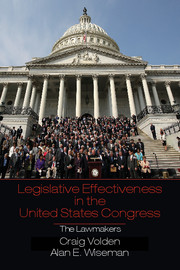Book contents
- Frontmatter
- Contents
- List of Tables and Figures
- Acknowledgments
- 1 Introduction
- 2 Measuring Legislative Effectiveness
- 3 The Keys to Majority-Party Effectiveness in Congress
- 4 A Tale of Three Minorities
- 5 Gridlock and Effective Lawmaking, Issue by Issue
- 6 The Habits of Highly Effective Lawmakers
- 7 The Future of Legislative Effectiveness
- References
- Index
3 - The Keys to Majority-Party Effectiveness in Congress
Published online by Cambridge University Press: 05 November 2014
- Frontmatter
- Contents
- List of Tables and Figures
- Acknowledgments
- 1 Introduction
- 2 Measuring Legislative Effectiveness
- 3 The Keys to Majority-Party Effectiveness in Congress
- 4 A Tale of Three Minorities
- 5 Gridlock and Effective Lawmaking, Issue by Issue
- 6 The Habits of Highly Effective Lawmakers
- 7 The Future of Legislative Effectiveness
- References
- Index
Summary
The fact is that no theoretical treatment of the United States Congress that posits parties as analytic units will go very far.
– David Mayhew, Congress: The Electoral Connection (1974, 27)First, let me admit that if I were writing The Electoral Connection today I would back off from claiming that “no theoretical treatment of the United States Congress that posits parties as analytic units will go very far.” Still, I have not seen any evidence that today’s congressional party leaders “whip” or “pressure” their members more frequently or effectively than did their predecessors thirty years ago.
– David Mayhew, Congress: The Electoral Connection (2nd Edition, 2004, xvii)The victors were celebrating across Michigan that night. In the Upper Peninsula, Bart Stupak was celebrating his reelection to an eighth term in Congress. On November 7, 2006, the Roman Catholic, pro-life, former police officer once again handily defeated the same Republican he had overcome in 2002 and 2004, each time more than doubling his opponent’s vote share.
Far to the southeastern part of the state, Joe Knollenberg was celebrating a much tighter race. Also a white, male, Roman Catholic, seven-term member of Congress, the incumbent was feeling the changing nature of his district – still able to rely on the Republican-leaning city of Troy and the conservative suburbs of Oakland County, but noticing the rising tide of Democratic support near Detroit, and a Democratic surge in the 2006 election year more generally. The previously safe Republican had to spend nearly $3 million to defeat his Democratic opponent by six points. Yet, despite a more uncertain race, and thus a more satisfying victory, Knollenberg’s celebration was perhaps a bit less enthusiastic than that of the Stupak camp.
- Type
- Chapter
- Information
- Legislative Effectiveness in the United States CongressThe Lawmakers, pp. 60 - 84Publisher: Cambridge University PressPrint publication year: 2014



